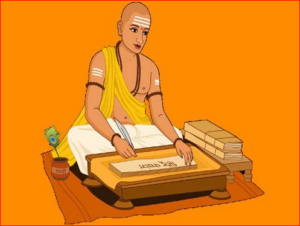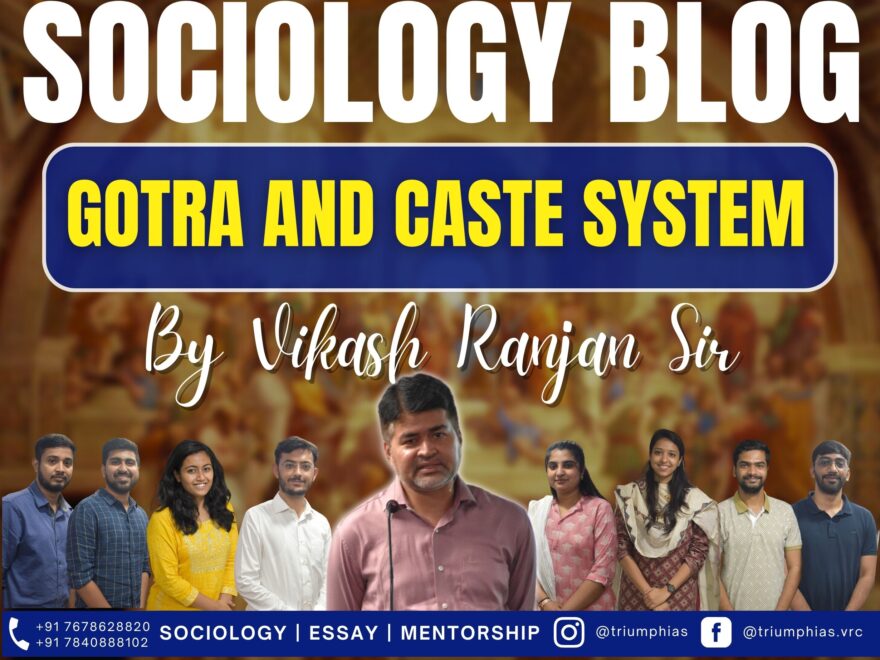Concept of Gotra and Caste System
(Relevance: UPSC Sociology Optional Paper 2, Unit – 12)

Introduction
Hello, dear readers! Welcome back to our platform, where we tackle intellectually stimulating subjects that fuel our collective curiosity. Today, we’re wading through the deep waters of India’s complex societal structure to uncover the nuanced concept of ‘Gotra‘ and its interplay with the caste system. As we dig into this thought-provoking topic, we will be aided by sociological perspectives from pioneering scholars like Emile Durkheim and G.S. Ghurye. So, grab a cup of tea, sit back, and join us on this enlightening journey.
Section 1: The Genesis of Gotra—Unveiling the Origins
From Vedic Roots to Modern Interpretation
To appreciate the sociological significance of ‘Gotra,’ it’s vital to understand its historical roots. The term originated in the later Vedic age and was initially related to the concept of a “cow pen,” a communal space where cattle were kept. This seemingly simple term has undergone a remarkable transformation over millennia, evolving into a system that symbolizes ancestral lineage and dictates marital alliances.
The Mythological Underpinnings: More Than Just Ancestral Lineage
- The Seven Sages and the Dawn of Gotra: The genesis of Gotra, according to Indian mythology, is fascinatingly spiritual and cosmic. It traces back to the concept of the Saptarishi, or the “Seven Sages,” who were the earliest seven sages appearing in ancient Hindu texts. Each of these sages—Kashyapa, Atri, Vashista, Vishwamitra, Gautama, Jamadagni, and Bharadwaja—is believed to have been a progenitor of a specific Brahmin clan. These clans, in turn, form the earliest known Gotras.
- The Sages in Mythological Lore: Each of these sages has a rich mythological backstory filled with divine interactions, cosmic responsibilities, and ancient wisdom. For instance, Kashyapa is considered the ‘Father of Humanity’ and is credited with creating diverse species, both celestial and terrestrial. Similarly, Vashista was the family priest to the line of Lord Rama, an avatar of Vishnu, who is a primary deity in Hinduism. These stories not only reflect the diverse cultural facets of India’s spiritual heritage but also serve as foundational texts that give a deeper meaning to the concept of Gotra.
- Gotra as a Cosmic Blueprint: Beyond its social and marital implications, Gotra serves as a kind of cosmic blueprint that spiritually connects individuals back to these revered sages, thereby linking them to the very act of cosmic creation, according to Hindu belief. This adds a profound spiritual layer to the understanding of Gotra; it’s not merely a social construct but a metaphysical concept that ties individuals to the eternal, cyclical rhythms of the universe.
- The Expansion of Gotra Systems: Over time, the concept of Gotra expanded beyond Brahmins and the original seven sages. Today, various Indian communities and even some non-Hindu communities recognize the concept of Gotra, each with their variations of the system. Despite this expansion, the mythological origins often remain as the spiritual cornerstone upon which the broader understanding of Gotra is built.
- Modern Interpretation of Mythological Texts: Modern scholars and individuals vary in how literally they interpret these ancient myths. For some, the mythological roots provide a sacred validation for upholding the Gotra system. For others, these stories serve more as symbolic narratives that carry psychological, cultural, and moral truths. Either way, the mythological underpinning serves to imbue the concept of Gotra with a sense of ancient wisdom and cosmic significance.
Section 2: The Sociological Lenses—Durkheim and Mechanical Solidarity
Emile Durkheim’s Theory
The French sociologist Emile Durkheim introduced the concept of ‘mechanical solidarity,’ which referred to the social cohesion and integration in traditional or archaic societies where individuals have similar responsibilities, beliefs, and ways of behaving. Durkheim argued that in such societies, social order is maintained through the likeness of individuals.
Gotra as a Form of Mechanical Solidarity
In a striking parallel, Gotra serves as a form of ‘mechanical solidarity’ in the contemporary Indian landscape. It functions as an adhesive social force, uniting people under a common identifier that reflects not just familial but also social, economic, and symbolic capital. These are intangible assets that profoundly shape an individual’s identity and social standing, forming a foundational aspect of their life experiences.
Section 3: Marriage and Gotra—The Ghurye Analysis
G.S. Ghurye and His Study on the Caste System
G.S. Ghurye, one of the founding figures of Indian sociology, extensively explored the caste system’s characteristics and functionalities. He discussed how caste serves as a vital determinant in the architecture of Indian society, including its impact on marital unions.
Gotra’s Role in Marital Choices
Gotra has far-reaching implications on the institution of marriage in India. Ghurye’s framework helps us understand how this operates, by emphasizing the importance of caste endogamy (marriage within the same caste) and Gotra exogamy (marriage outside the same Gotra). These principles have endured through ages, inscribed in social norms and religious tenets, shaping individual choices and familial decisions.
To master these intricacies and fare well in the Essay Writing for UPSC, aspiring Civil Servents might benefit from guidance by the Best Essay Mentorship Teacher and participation in the Best Essay Writing Coaching. These avenues provide comprehensive assistance, ensuring a solid understanding of Essay Writing diverse methodologies and techniques.
Concept of Gotra, concept of gotra upsc sociology, concept of gotra, gotra upsc, what is gotra in sociology, what do you understand by gotra, gotra in sociology, Relation of Gotra, gotra meaning in sociology, definition of gotra, g.s. ghurye sociology upsc, interpretive sociology upsc, kkhsou sociology notes, 4 gotra, 4 types of gotra, 7 gotra, 8 gotra, 8 gotra of brahmin, 9 gotra, Gotra, Sociological Analysis, Indian Society, Caste System, Emile Durkheim, G.S. Ghurye, Sociological Analysis, Mechanical Solidarity, Marriage, Ancestral Lineage, Brahmins, Vedic Roots, Modern Interpretation, Cosmic Blueprint, Saptarishi, Hindu Mythology
Follow us :
🔎 https://www.instagram.com/triumphias
🔎https://www.youtube.com/c/TriumphIAS
https://t.me/VikashRanjanSociology
Find More Blogs
|
Scope of the subject and comparison with other social sciences |
|||
|
|
|
|
Modernity and social changes in Europe |

